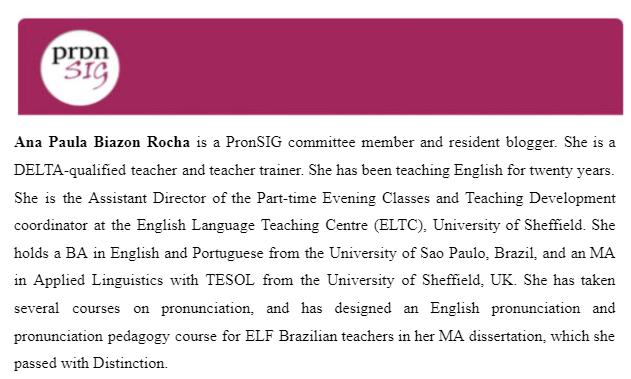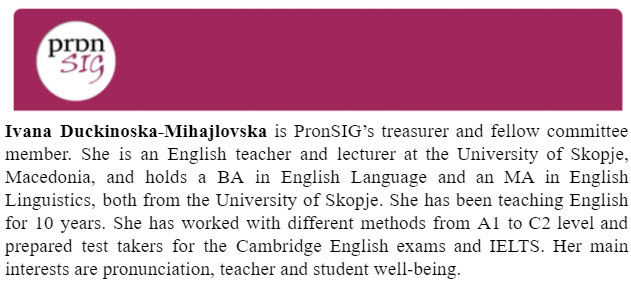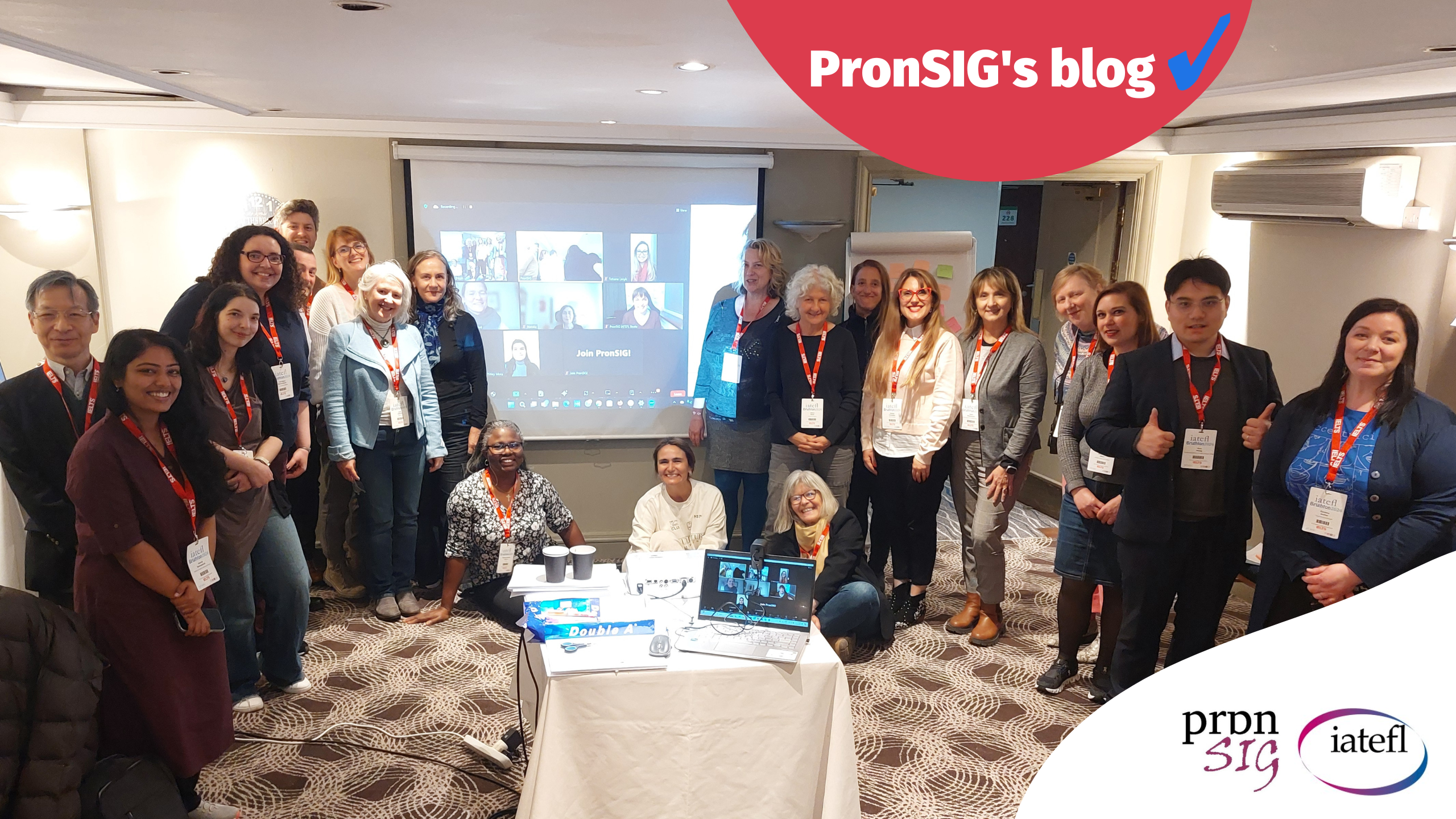by Ana P Biazon Rocha and Ivana Duckinoska-Mihajlovska
As mentioned in our March 2024 post, PronSIG’s Pre-Conference Event (PCE) Pronunciation ‘unplugged’: teachers as resources for low-tech classrooms, on Monday, 15 April 2024, aimed at reflecting and discussing how to teach pronunciation in contexts where technology and resources are scarce or not available. We focused on how we, teachers, are vital teaching resources to support our learners. We are glad to inform you that our PCE was extremely successful due to our active, highly-engaged participants and our great speakers. So, we are going to list four main highlights of our PCE in this post. Are you ready?
1. The importance of reflecting on our pronunciation teaching
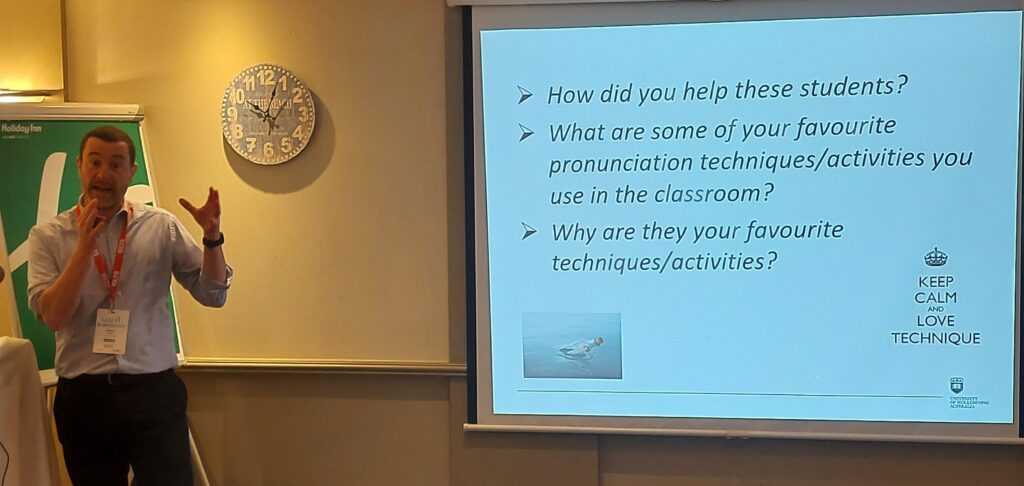
Image 1: M. Burri – PCE 2024
In our first session, ‘Let’s talk about it! Pronunciation teaching unplugged’, Michael Burri led a series of discussions on:
- who we are as pronunciation teachers
- what challenges we usually face to teach pronunciation in our contexts
- what ‘stories’ our students have brought to us about their personal challenges with pronunciation and how we have helped these students
- some of your favourite pronunciation techniques/activities we use in the classroom
- and what questions we had about pronunciation teaching.
This was important to start the day since we could get to know each other a bit more and share our experiences, concerns and tips. It was also an excellent chance to take stock of what we had been doing in our pronunciation teaching until then, and what we wanted to adapt, change, improve or keep on doing after the PCE with our learners. Thus, we also invite you to take a moment and reflect on the points above for your own teaching development. If you want, you can share your reflections with us in the comments section below. We are looking forward to hearing from them!
2. Using graphic facilitation for teaching intonation
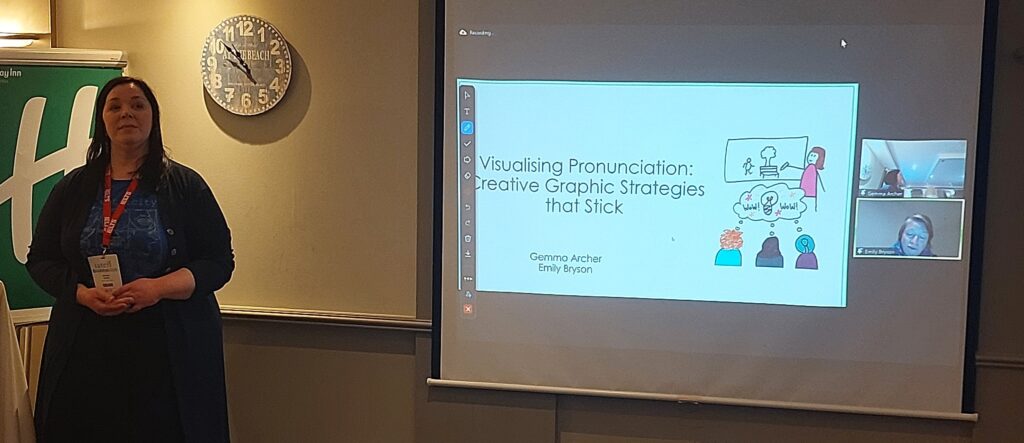
Image 2: E. Bryson & G. Archer – PCE 2024
Next, we had Emily Bryson and Gemma Archer who delivered an interesting talk titled ‘Visualising Pronunciation: Creative graphic strategies that stick’, where they explored the benefits of graphic facilitation for teaching various segmental and suprasegmental features. While they covered numerous activities, our takeaway for this blog will be the one that highlights the use of graphic facilitation for teaching intonation.
The idea behind this is to make intonation visible to learners. For example, when teaching sentence stress, it is essential that learners become aware that the main prominence usually falls on the final content word, unless the speaker intends to send a different message, as illustrated in the contrast ‘What do you WANT?’ and ‘What do YOU want?’ For this purpose, learners can be encouraged to draw, rather than write, the final content word in the sentence. Here, we are going to use the examples from the talk: ‘I need a pencil,’ and ‘Can I have an apple?’ In these two sentences, the learners must listen carefully for the final content words, ‘pencil’ and ‘apple’, before capturing them with drawings. Then, a nearly straight line can be drawn over the sentences, indicating that all words are generally of equal prominence. However, a rising line should be drawn over the stressed syllable of the content words – ‘pen’ in ‘pencil’ and ‘app’ in ‘apple’ – which then goes down again for the unstressed syllable. Activities of this kind can help learners visualise sentence stress and gain better insight into English rhythm and intonation. By using drawings for pronunciation practice, teachers can make abstract concepts more understandable, engaging and fun for learners.
3. Using numbers for teaching minimal pairs
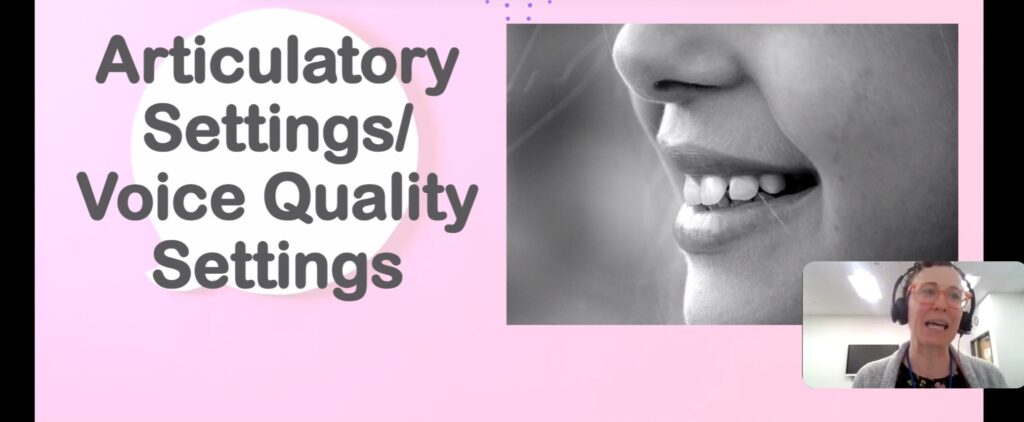
Image 3: A. Echelberger – PCE 2024
Our third talk of the day was delivered by Andrea Echelberger, titled ‘The hidden population: Teaching pronunciation to literacy level adult language learners.’ Echelberger began by explaining that these learners usually lack formal education or are learning to read for the first time as adults. However, the activities she outlined are not limited to this target group and can be easily applied in the general EFL classroom. One such activity involves using numbers, particularly phone numbers, to teach minimal pairs.
Students are introduced with a list of minimal pairs. Here, we will use the example illustrated in the talk, where the target feature is the contrast /p/ – /b/. Numbers 0–9 are represented with words, e.g., 0 – pack, 1 – back, 2 – rope, 3 – robe, 4 – pig, 5 – big, and so on. Then, one student says their phone number, replacing each digit with the corresponding word, for example ‘big, rope, robe, pack, back, pig’. The rest of the group writes down the number, which in this case would be 523014. Students then take turns saying their phone numbers. This activity is very engaging as it encourages active participation from the entire group by allowing each participant to practise both production and perception of minimal pairs.
4. Enhancing pronunciation teaching through actor training techniques and oral narration
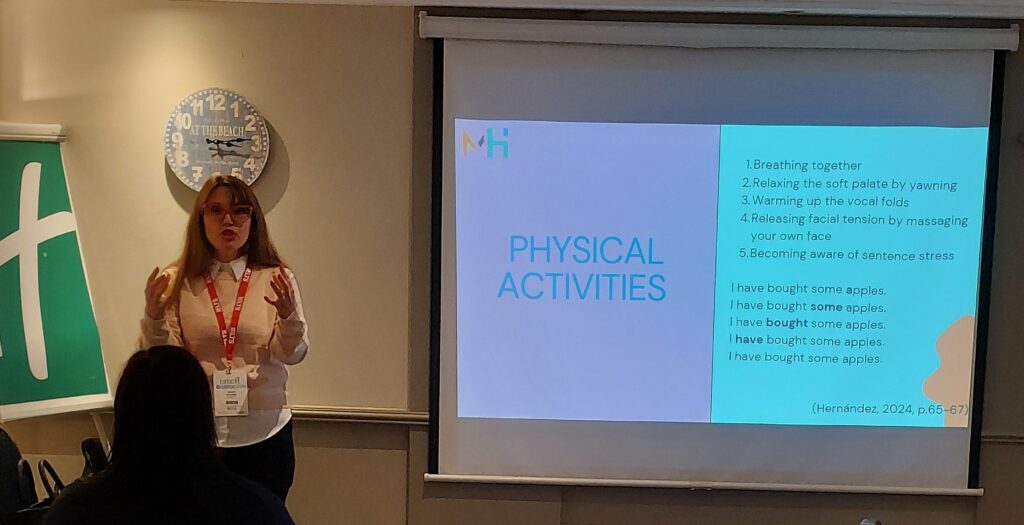
Image 4: M. Hernández – PCE 2024
In the final session of the day, Marisol Hernández combined her English pronunciation and acting expertise to suggest new approaches to pronunciation instruction such as incorporating actor training techniques to involve learners and create a stimulating learning environment, where students own their learning of pronunciation. She had online and in person participants engage in:
- breathing together
- relaxing the soft palate by yawning
- warming up the vocal folds
- releasing facial tension by massaging their own face
- becoming aware of sentence stress.
Then, she explained how we can introduce oral narration to our lessons to help raise learners’ awareness of stress, pausing, breathing and body language altogether. You can choose any short excerpt from a play, a novel, a film, whatever you deem suitable for your students’ level and interest. First, make sure they understand the excerpt, in other words, what it means, what it is talking about. Second, help them identify sentence stress, or the most prominent word in the sentence, and pausing, also known as chunking, usually a phrase, clause or sentence that represents a thought group. Third, have them annotate these features such as adding double bars || for pausing, and ask them questions such as why there should be a pause or not in a given sentence, which emotions are being conveyed, what is happening in the story, etc. Finally, have them practise reading the excerpt aloud, adding breathing and body language as if they were actors on a stage. Learners can record themselves if they want. Participants had a go at a few excerpts that Hernández showed us, and honestly, some of them were ready to try acting school! If you want to investigate these ideas further, make sure you check Hernández’s (2024) recent release (see reference below).
All in all, our PCE was incredibly engaging and remarkably productive. We hope you can be inspired by it, and add more pronunciation to your teaching practices as well as get to know more about PronSIG. Who knows, we may see you at our next PCE in 2025!
You can check previous blog posts here. Don’t forget to leave your comments below and follow us on social media.
Reference
Hernández, M. (2024). English Pronunciation Through Acting Exercises and Techniques: A Handbook for Learners, Teachers, and Other Language Professionals. Editorial UMSA.
